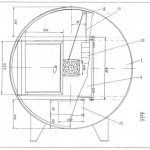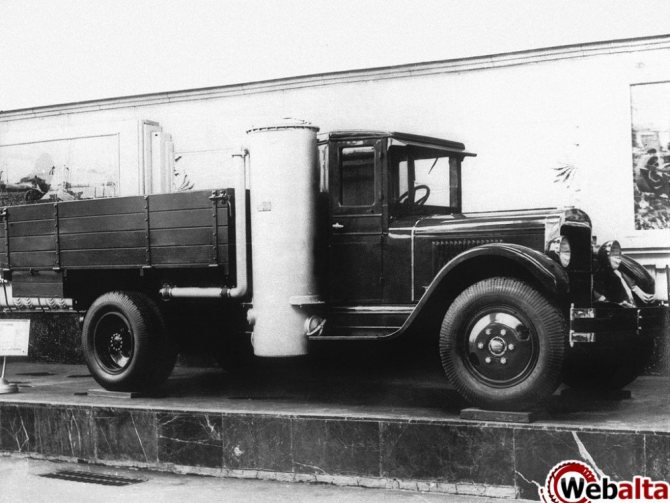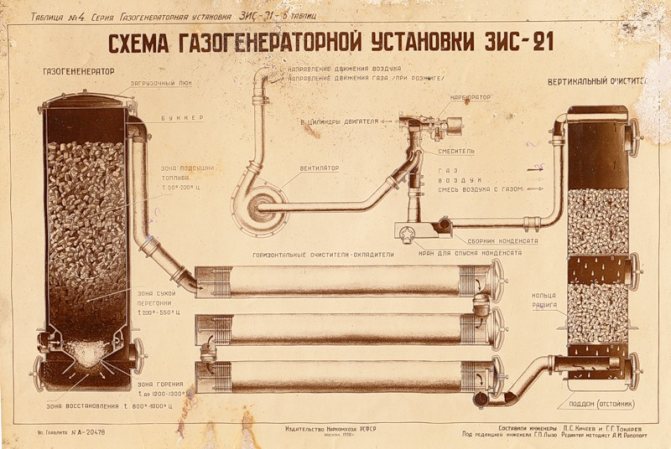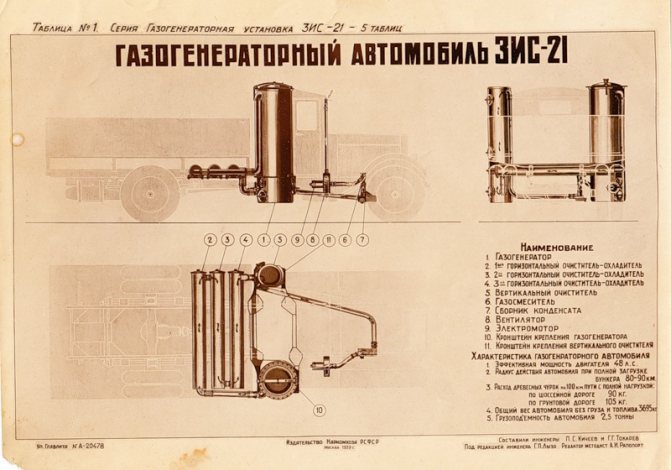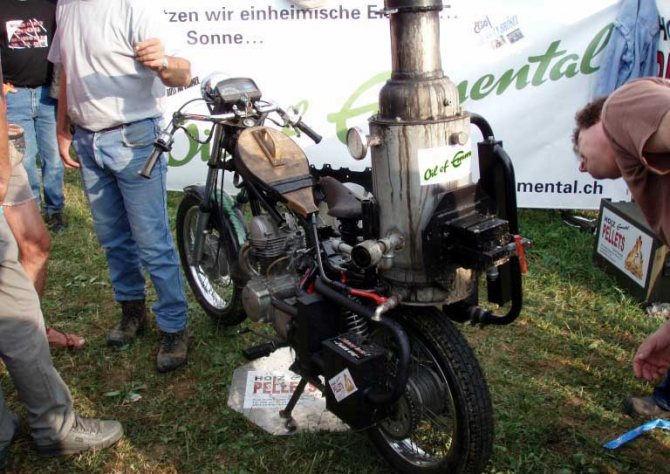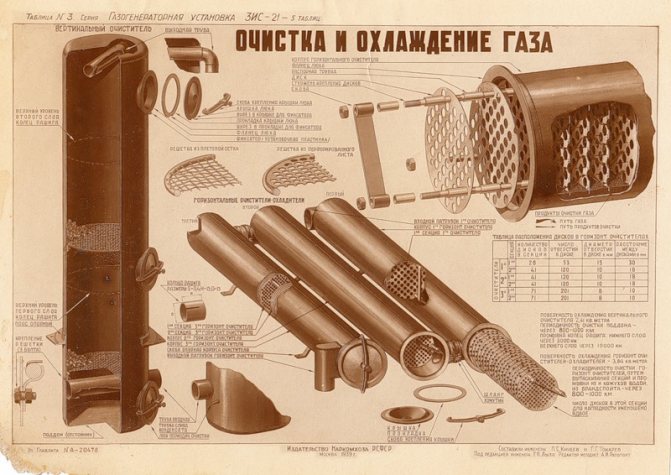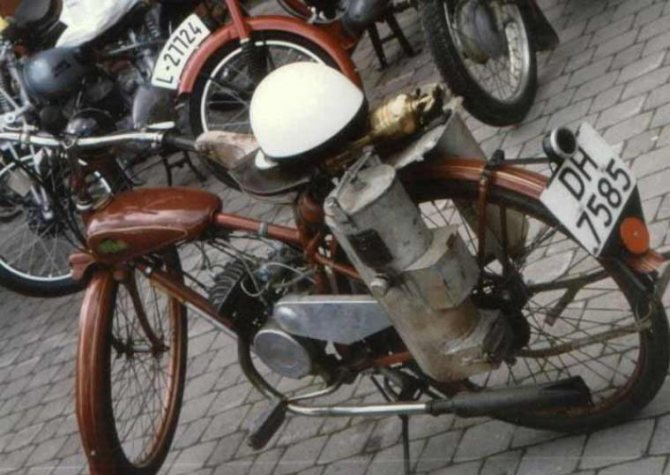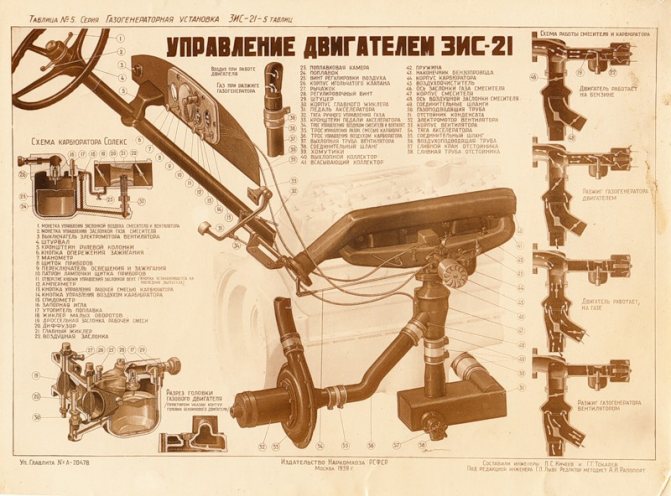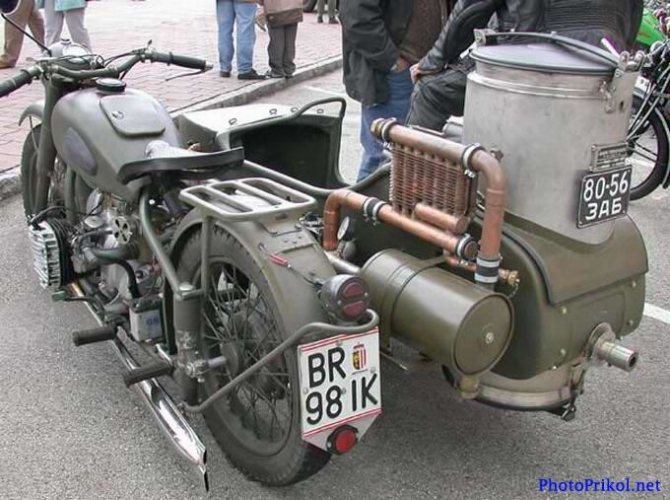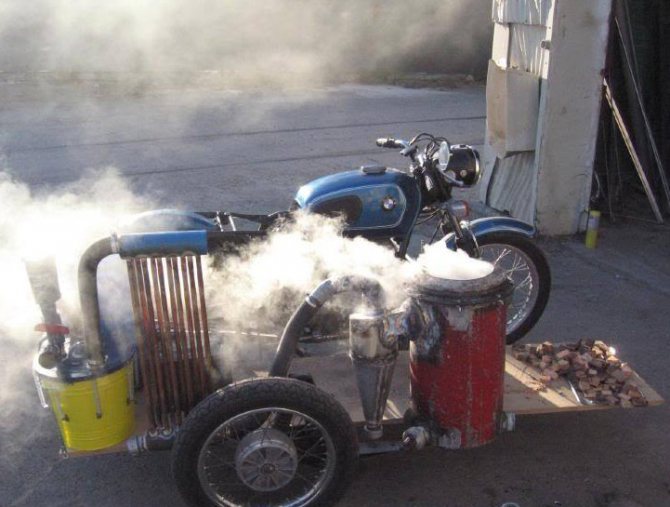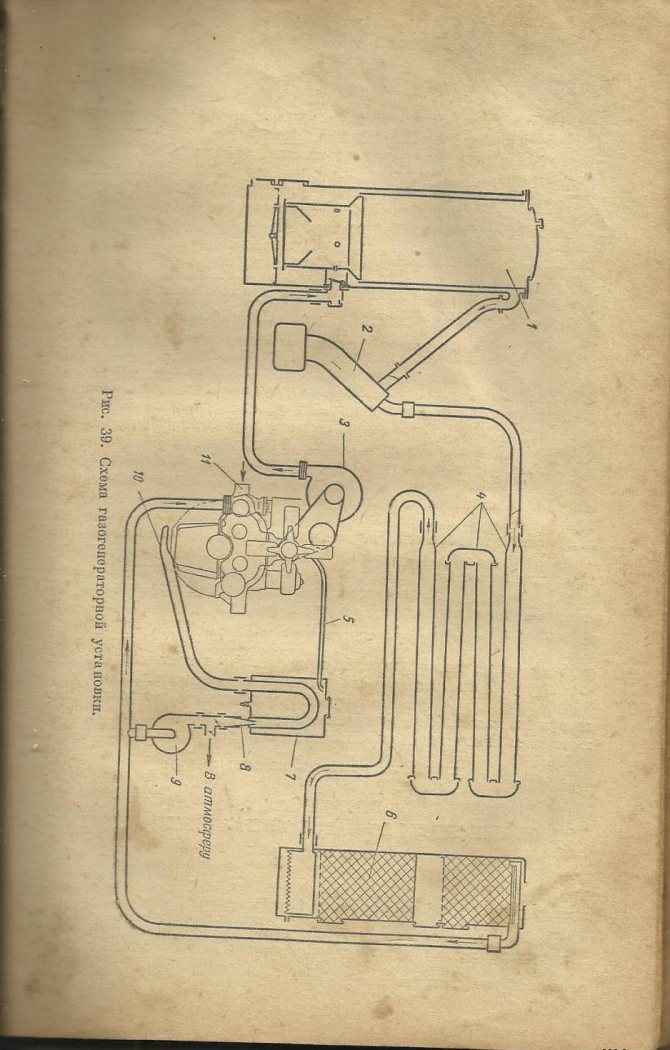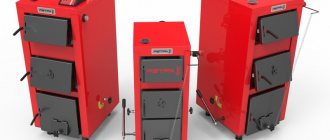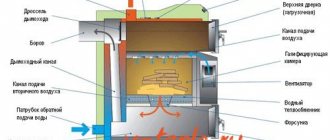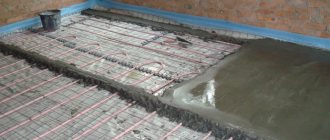At the moment, there are many ways to obtain gas. Each device is based on a gasgene system. Its working principle is gas processing of wood into heat.
A gas generator has been developed as an additional method of generating energy. Today gazgen is considered to be an excellent multifunctional equipment. Such a unit is used to heat cars and rooms. The principle of boiler operation is not straightforward. Wood-fired gasgene consists of numerous necessary elements.
It is allowed to use both purchased devices and handmade ones.
Assembly drawing:
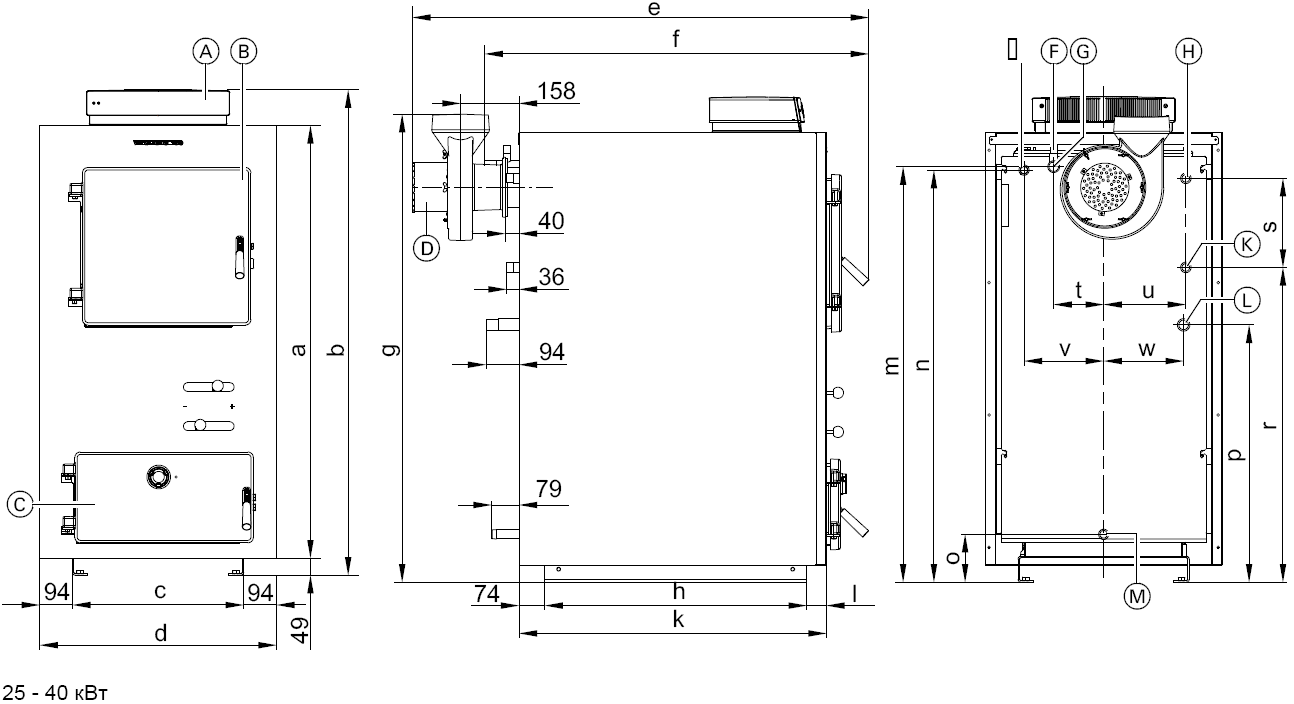
Video about the device of a homemade gas generator
Benefits of gazgen
- The efficiency of such boilers varies within 78-96%;
- One tab on the wood burns up to 12 hours. With top burning, the time increases to 1 day. The corner burns for more than 1 week;
- The fuel material burns out completely. Because of this, the gas duct is cleaned no more than 1 time per month;
- You can set up automated work;
- The smallest number of harmful components gets into the air;
- Financially such devices are the most economical;
- It is recommended to use wood dried up to 50% as a full-fledged fuel source;
- The use of non-chopped logs, reaching a length of 1 m, is allowed;
- Disposal of polymers is permitted in boilers;
- The device is highly secure.
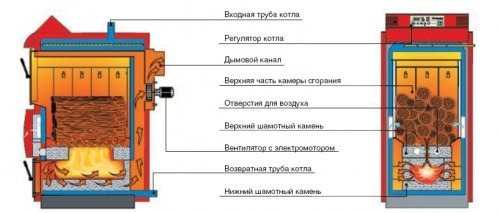

The principle of operation of the unit
Combustible gas can be produced from any type of fuel in gasgene. The main secret is that oxygen gets into the chamber. The volume of oxygen supplied is not enough for full combustion of wood. In the process itself, a sufficiently high temperature must be observed, exceeding 1200 ° C. The produced gas is gradually cooled down, getting to the source of consumption or the car engine.
Gas generator device
The main difference between gazgens on solid materials is that in all cases of operation of the unit on wood the process of combustion of material and wood gas is observed.
Soot is not emitted in this case.
The device and principle of operation of a wood-fired gas generator
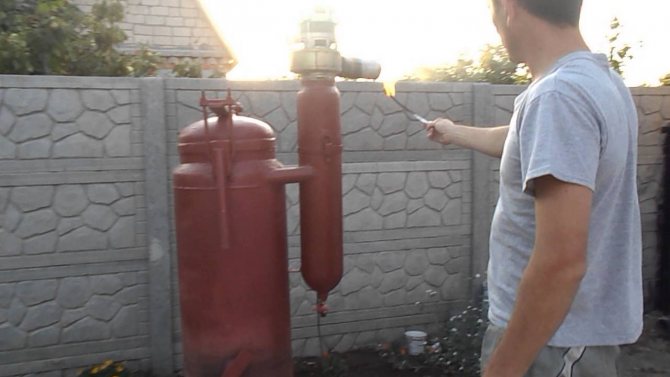

Combustible gas can be obtained by burning wood in a gas generator
Under normal conditions, with free access of oxygen, the process of burning wood is accompanied by the release of a certain amount of heat. But when there is not enough oxygen for active combustion, the wood smolders to form wood gas, which includes flammable gases CO (carbon monoxide), H2 (hydrogen), CH4 (methane) and unsaturated hydrocarbons without tar. Also, non-flammable substances are formed at the outlet: CO2, O2, N2, H2O, which are ballast, ultimately the gas mixture must be cleaned from them.
The gas generator is arranged as follows:
- The body is made of steel, most often of a cylindrical shape. There is a filling chamber into which fuel is loaded. The camera is installed inside the housing and secured with bolts. The loading chamber hatch is equipped with a seal.
- The combustion chamber is installed in the lower part, from the inside it is ceramic. The fuel burns in it. The cracking of resins occurs in its lower part - there is a chrome steel neck with an asbestos cord, which acts as a sealing gasket between it and the body.
- Air is fed into the combustion chamber through openings connected to the air distribution box, the so-called lances. A check valve is installed at the outlet of the chamber to prevent the escape of flammable gas.The fan installed at the inlet allows you to increase the engine power or burn fuel with a moisture content of more than 50% in a wood-fired gas generator.
- The grate is located at the bottom of the gas generator and is designed to hold hot coals. It has holes through which the ash falls into the ash pan. Its middle part is movable so that it can be cleaned.
- There are several loading hatches: an upper one with a shock absorber that lifts the lid when overpressure, and two side ones: one above for adding fuel to the recovery zone, and the other below for removing ash.
- A cyclonic vortex type filter is located behind the housing. Coarse gas cleaning is carried out here. Then the gas mixture is cooled in a cooler and enters a fine filter. After the filter, it is sent to the mixer, where it is saturated with air. Then the gas-air mixture goes to the place of use.
The pipeline through which the gas is transported to the place of direct use is most often connected to a branch pipe installed in the recovery zone. While the gas is hot at the outlet of the gas generator, it can be used to heat water, dry firewood in the loading chamber. For example, in the latter case, the pipe is passed between the gas generator casing and the filling hopper.
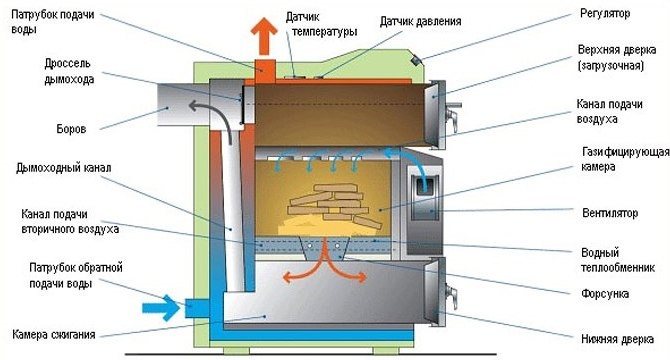

Homemade gas generator device
The combustible gas in the gasifier is obtained as follows:
- In the upper part of the loading chamber, the temperature is between 150-200 ° C. Due to the fact that a circular pipeline is organized through which hot gas, which has just left the gas generator, passes, the firewood is dried here.
- The middle part of the bunker is a dry distillation zone. At this level, the fuel is charred at a temperature of 300–500 ° C without access to air. Tar and acids are released from the fuel.
- In the combustion zone, which is located below the combustion chamber, the temperature is maintained at 1100-1300 ° C. The charred fuel, as well as the resins and acids released from it, are combusted by the supply of air to form CO and CO2 gases.
- The recovery zone is located above the combustion zone: between it and the grate. The CO2 gas, which is formed in the combustion zone, rises upward, overcomes the hot coal and interacts with the carbon of the coal, thus reducing to the formation of carbon monoxide. Besides CO, CO2 and H2 are also produced.
At the exit from the recovery zone, the gas mixture is cooled, then cleaned from acetic and formic acid, ash particles and mixed with air.
Installation and place of installation
Installation is prohibited:
- In crowded places;
- In poorly lit rooms;
- In the cellar and basement;
- Near devices that emit harmful substances;
- Near flammable machines;
- Near self-exploding mixtures;
- Near acetylene-releasing material;
- In coal-fired and wood-fired boilers;
- Near compressors, air conditioners, and ventilators taking oxygen;
- At a distance of less than 1 m from gas heaters;
- Near thermal and electrical devices;
Install the device away from driveways and walkways. It must be fenced.
Installation must be carried out in places inaccessible to children and pets. The device requires constant supervision.
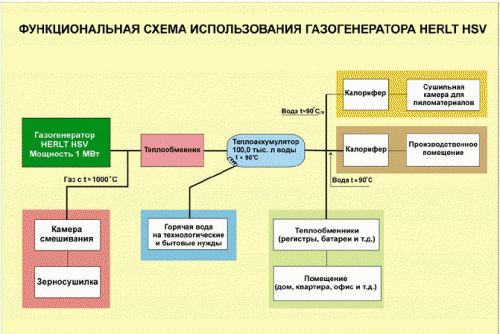

Gas generator myths
On the Internet, there are often many unsubstantiated statements about the operation of such units and conflicting information is given about the use of gas generators. Let's try to dispel all these myths.
The first myth sounds like this: the efficiency of a gas-generating plant reaches 95%, which is incomparably higher than that of solid fuel boilers with an efficiency of 60-70%. Therefore, it is much more profitable to heat the house with its help.The information is incorrect initially, it is impossible to compare a household gas generator for a house and a solid fuel boiler, these units perform different functions. The task of the first is to generate combustible gas, the second is to heat the water.
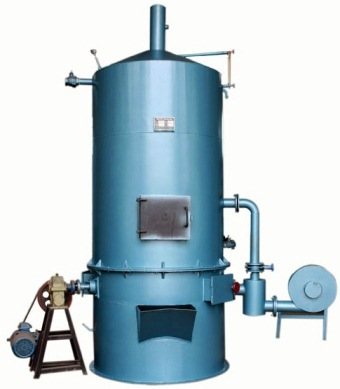

When we talk about generating equipment, then its efficiency is the ratio of the amount of product obtained to the volume of gas that can theoretically be extracted from wood, multiplied by 100%. Boiler efficiency is the ratio of the generated heat energy of the wood to the theoretical calorific value, also multiplied by 100%. In addition, not every biogas plant, let alone a gas generator, can extract 95% of combustible fuel from organic matter.
Output. The essence of the myth is that they are trying to compare mass or volume through efficiency with units of energy, and this is unacceptable.
It is easier and more efficient to heat a house with a conventional pyrolysis boiler, which in the same way releases combustible gases from wood and immediately burns them using the secondary air supply to an additional combustion chamber.
The second myth - you can put fuel of any moisture in the bunker. It can be loaded, but only the amount of gas released drops by 10-25%, or even more. In this regard, the ideal option is a gas generator that runs on charcoal, which contains almost no moisture. And so the thermal energy of pyrolysis goes to the evaporation of water, the temperature in the furnace drops, the process slows down.
The third myth - the cost of heating a building is reduced. It is not difficult to check, it is enough to compare the cost of a wood-fired gas generator and an ordinary solid fuel boiler, also made by hand. Plus, you need a hot water device that burns wood gases, for example, a convector. Finally, operating this entire system will take a lot of time and effort.
Output. A homemade wood-fired gas generator, made by hand, is best used in conjunction with an internal combustion engine. That is why home craftsmen adapt it to generate electricity at home, or even fit the installation on a car.
Car gas generator
It must be understood that a gas generator for a car must be compact enough, not too heavy and at the same time efficient. Foreign colleagues, whose incomes are not much higher than ours, make the generator body, cyclone and cooling filter from stainless steel. This allows you to take the thickness of the metal in half, which means that the unit will come out much easier. In our reality, pipes, old propane cylinders, fire extinguishers and other improvised materials are used to assemble a gas generator.
Below is a drawing of a gas generator installed on old UralZIS-352 trucks, according to which you need to navigate when assembling the unit:
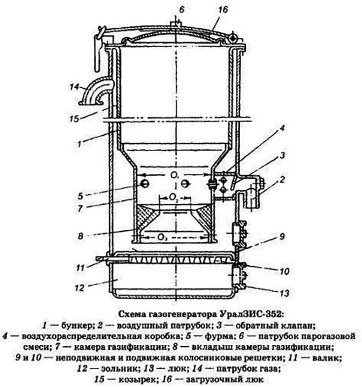

Our craftsmen most often make the outer container from LPG cylinders, the inner one can be made from the receiver of a ZIL or KAMAZ truck. The grate is made of thick metal, the branch pipes are made of the corresponding pipe diameter. The lid with clamps can be made from the cut off top of the cylinder or from sheet steel. The cover is sealed with a graphite impregnated asbestos cord.
A coarse filter - a cyclone for a car is made from an old fire extinguisher or a simple piece of pipe. At the bottom of the pipe, a conical nozzle with a fitting for unloading ash is made, on top of the end, the end is closed with a tightly welded cover. The outlet for the cleaned gases is cut into it, and on the side is the second nozzle, where the combustion products will be fed. The functional diagram of the cyclone in section is shown in the figure:
Since the automobile gas generator produces gases with a high temperature, they need to be cooled. There are two reasons:
- incandescent gaseous fuel has too low a density and it will not be easy to ignite it in the internal combustion engine cylinders;
- there is a danger of spontaneous flash on contact with hot motor surfaces.
The movement of gases along the entire path during ignition is provided by the fan, and after starting the motor, the necessary vacuum appears in the system, the fan is turned off.
For cooling, craftsmen use conventional ribbed heating radiators, placing them on the car in such a way that they are blown out with air as much as possible while driving. Sometimes even modern bimetallic radiators are used. Before entering the gas generator engine, the fuel requires fine cleaning; for this, various types of filters are used at their discretion. All units are combined into one unit in accordance with the diagram:
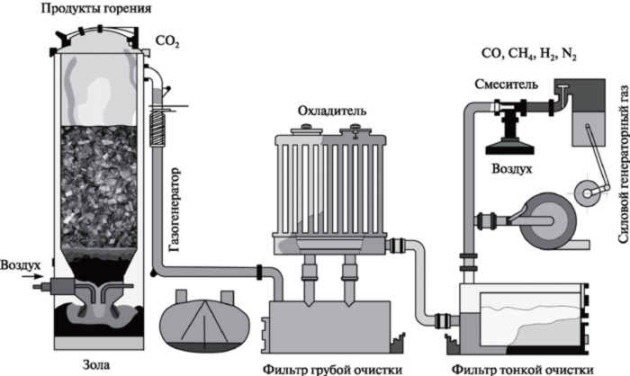

And the last detail - a mixer, is needed to regulate the proportions of the gas-air mixture. The fact is that wood gas has a calorific value of only 4.5 MJ / m3, while natural gas used in cars is as much as 34 MJ / m3. Therefore, the proportions of fuel and air must be different, they need to be adjusted with a damper.
Repair and service
Easier to service purchased gasgen... A hand-made device requires more effort and time. The gas generator must be suspended in the event of a gas leak. It is also forbidden to use the device if it needs to be repaired. After turning off the gas generator, it is necessary to thoroughly ventilate the room, remove small children and animals from the building. All gas must be released, water drained. The mine is thoroughly cleaned from the remnants of sludge and carbide. The generator itself is completely disassembled and washed with water. At the moment there are a large number of private and public companies engaged in the repair of gas generators. The standard cost of repairs varies between 1500-6000 rubles.
When flushing the device, it is necessary to use water without the presence of chemical impurities.
Types of gas generators
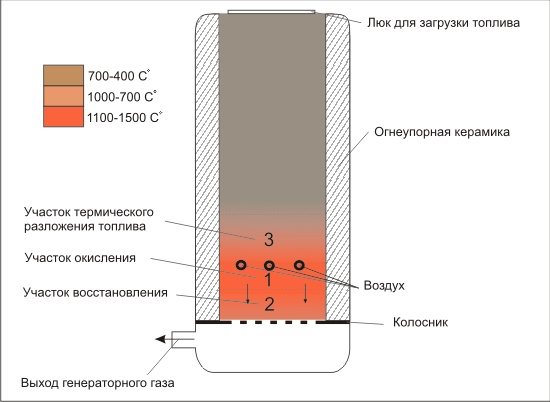

Reverse process gasifier
Distinguish between direct, reverse and horizontal process gas generators. In gas generators with a direct type of gas generation, air is supplied from the bottom through the grate, and the gas is taken from the top. Such a gas generator is ideally suited for combustion of semi-coke and anthracite coal. The power of the generator is increased by enriching the gas with hydrogen from water.
The reverse process gas generator differs in that air is supplied to the combustion zone, in the middle part, and gas is taken from the ash pan, below the combustion zone. In such a gasifier, gas is usually used to heat wood. The device is optimally suited for burning fuels containing tar: wood waste, firewood, charcoal.
In gas generators of a horizontal process, air is supplied from the side, at the bottom, and a fan is installed at the outlet of the air intake chamber to blow air. The active zone takes up a small space - between the lance hole and the gas outlet grate. Such a generator heats up quickly and reacts to changes in operating modes.
The pyrolysis boiler has an improved design compared to a simple gas generator. It has two combustion chambers: in the first of them, fuel burns and flammable gas is formed, and in the other, the gas burns and heat is transferred to the coolant. To convert the gas generator into a pyrolysis boiler, you need to add another combustion chamber and heat exchanger.


Pyrolysis generators completely burn wood, therefore they are more economical and environmentally friendly
The scheme of the pyrolysis gas generator is as follows:
- Air is fed into the combustion chamber through the adjustable window of the primary air intake chamber until the wood is ignited.
- The oxygen supply is reduced. The boiler goes into gas generation mode, the wood starts to smolder slowly. This is achieved with the help of an automatic regulator, which reduces the entry of air into the firebox.
- As a result, pyrolysis gas starts to evolve.He enters the afterburner.
- When the boiler switches to gas generation mode, secondary air is supplied for afterburning. Until the air reaches the desired chamber, it heats up to a temperature at which it reacts with the pyrolysis gas.
- Air distributors with holes are located in the upper chamber. Secondary air enters through them, igniting fuel gases. This converts the pyrolysis gases into heat energy.
Emissions of hazardous oxides into the atmosphere are minimal, the temperature of the gases from the wood leaving the pyrolysis gas generator does not exceed 130-160 ° C. The coolant travels from the bottom to the top of the boiler, taking heat energy from all surfaces.
DIY making
Making gazgen with your own hands - painstaking and difficult work... You will need special materials to complete it. Steel is needed to make the hull and fuel tank. For special containers - heat-resistant material. You will also need heat-resistant gaskets made of any material other than asbestos, as it releases hazardous substances. Pipes are required to connect the nodes. Filters will be required to remove any impurities.
Do-it-yourself plot about gazgens
When making a gas gene with your own hands, it is important to take into account that all parts and assemblies of a gas gene must be breathable.

